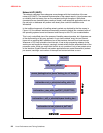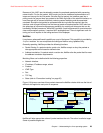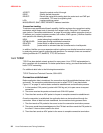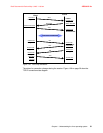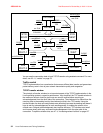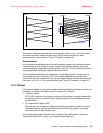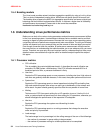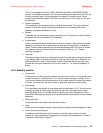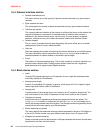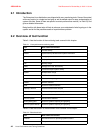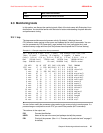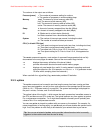4285ch01.fm Draft Document for Review May 4, 2007 11:35 am
36 Linux Performance and Tuning Guidelines
1.6.3 Network interface metrics
Packets received and sent
This metric informs you of the quantity of packets received and sent by a given network
interface.
Bytes received and sent
This value depicts the number of bytes received and sent by a given network interface.
Collisions per second
This value provides an indication of the number of collisions that occur on the network the
respective interface is connected to. Sustained values of collisions often concern a
bottleneck in the network infrastructure, not the server. On most properly configured
networks, collisions are very rare unless the network infrastructure consists of hubs.
Packets dropped
This is a count of packets that have been dropped by the kernel, either due to a firewall
configuration or due to a lack in network buffers.
Overruns
Overruns represent the number of times that the network interface ran out of buffer space.
This metric should be used in conjunction with the
packets dropped value to identify a
possible bottleneck in network buffers or the network queue length.
Errors
The number of frames marked as faulty. This is often caused by a network mismatch or a
partially broken network cable. Partially broken network cables can be a significant
performance issue for copper-based Gigabit networks.
1.6.4 Block device metrics
Iowait
Time the CPU spends waiting for an I/O operation to occur. High and sustained values
most likely indicate an I/O bottleneck.
Average queue length
Amount of outstanding I/O requests. In general, a disk queue of 2 to 3 is optimal; higher
values might point toward a disk I/O bottleneck.
Average wait
A measurement of the average time in ms it takes for an I/O request to be serviced. The
wait time consists of the actual I/O operation and the time it waited in the I/O queue.
Transfers per second
Depicts how many I/O operations per second are performed (reads and writes). The
transfers per second metric in conjunction with the kBytes per second value helps you to
identify the average transfer size of the system. The average transfer size generally should
match with the stripe size used by your disk subsystem.
Blocks read/write per second
This metric depicts the reads and writes per second expressed in blocks of 1024 bytes as
of kernel 2.6. Earlier kernels may report different block sizes, from 512 bytes to 4 KB.
Kilobytes per second read/write
Reads and writes from/to the block device in kilobytes represent the amount of actual data
transferred to and from the block device.



